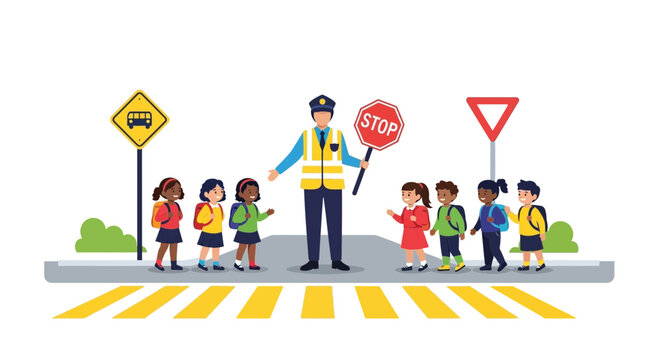In Kenya, ensuring the safety of schoolchildren as they navigate busy roads to and from school is a critical priority. With the rise in traffic congestion and road accidents, the role of school road crossing guards has become indispensable. The National Transport and Safety Authority (NTSA) has introduced the Draft Traffic (School Transport) Rules 2025, outlining specific requirements for crossing guards to enhance children’s safety at school entry and exit points and designated pedestrian crossings. This comprehensive guide explores the requirements, responsibilities, training, and tools needed for school crossing guards in Kenya, providing school managements, parents, and aspiring crossing guards with all the essential information. By delving into the qualifications, legal framework, and practical skills required, this article aims to empower stakeholders to foster safer school environments.
The Role of School Crossing Guards in Kenya
School crossing guards, also referred to as crosswalk attendants, are tasked with ensuring the safe passage of children and other pedestrians across roads near schools. Their primary responsibility is to manage and control vehicular and pedestrian traffic at designated crossings, school entry and exit points, and other high-risk areas. According to the NTSA’s Draft Traffic (School Transport) Rules 2025, crossing guards play a pivotal role in reducing road accidents involving schoolchildren, a group particularly vulnerable to traffic hazards.
Why Crossing Guards Matter
The introduction of crossing guards is a response to the growing concern over road safety in school zones. With only 15% of children walking to school today compared to 50% three decades ago, school zones are increasingly congested, heightening the risk of accidents. Crossing guards serve as vigilant custodians of safety, ensuring smooth traffic flow and protecting children from potential hazards. Their presence not only safeguards students but also instills confidence in parents, encouraging more children to walk or cycle to school.
Legal Framework Governing Crossing Guards
The Draft Traffic (School Transport) Rules 2025 provide a clear legal framework for the designation and operation of crossing guards in Kenya. Key provisions include:
- Designation by School Management: Schools may appoint individuals as crossing guards to manage traffic at entry and exit points or pedestrian crossings.
- Authority to Direct Traffic: Crossing guards have the legal power to stop motorists to allow children to cross safely, facilitate school transport vehicles, and ensure smooth traffic flow around school zones.
- Penalties for Non-Compliance: Drivers who fail to obey a crossing guard’s directives commit a traffic offense, which may result in fines ranging from KES 5,000 to over KES 1,000, points on their driving license, or other penalties.
This framework underscores the critical role of crossing guards in maintaining order and safety in school zones, aligning with Kenya’s broader road safety goals.
Requirements for Becoming a School Crossing Guard in Kenya
To serve as a school crossing guard, individuals must meet specific qualifications and undergo training to ensure they are equipped to handle the demands of the role. Below are the key requirements outlined by the NTSA and other relevant sources.
Educational and Background Requirements
While the role of a crossing guard does not require advanced academic qualifications, certain baseline criteria must be met:
- Minimum Education: This ensures that candidates have basic literacy and communication skills to interact with students, parents, and drivers.
- Background Check: Candidates must pass a thorough background check to ensure they have no criminal record, given their responsibility for children’s safety.
- Physical Fitness: The job involves standing for extended periods in various weather conditions, requiring good physical health, vision, and hearing to monitor traffic and pedestrian movement effectively.
Training and Skills Development
The NTSA mandates that crossing guards acquire necessary training in traffic control, management, and children’s safety. Training is typically provided on the job and covers the following areas:
- Traffic Control and Management: Guards learn how to assess traffic flow, identify safe crossing gaps, and use traffic control devices such as stop and go signs. They are trained to direct vehicles and pedestrians to ensure smooth and safe movement.
- Children’s Safety Protocols: Training emphasizes understanding child behavior, communicating safety rules, and assisting children with special needs or disabilities. Guards are taught to remain patient and vigilant, especially when dealing with young students.
- Kenyan Traffic Rules 2025: Familiarity with the latest traffic regulations, including speed limits in school zones (30 km/h) and the use of stop signal arms on school buses, is essential.
- Emergency Response: Guards are trained to act swiftly in emergencies, such as reporting reckless drivers or suspicious activities to school authorities or law enforcement.
Training programs may be facilitated by local law enforcement agencies, traffic engineering departments, or schools, often in collaboration with organizations like the Global Road Safety Partnership.
Essential Skills for Crossing Guards
Beyond formal training, crossing guards must possess a range of skills to perform their duties effectively:
- Communication Skills: The ability to interact courteously with children, parents, school staff, and drivers is crucial. Guards must clearly convey crossing instructions and safety rules.
- Observation and Judgment: Guards need keen observation skills to monitor traffic patterns and make quick decisions to ensure safe crossings.
- Patience and Reliability: Working with children requires patience, while reliability ensures consistency in maintaining safety during school hours.
- Physical Stamina: The role demands standing for long periods in varying weather conditions, requiring physical endurance.
Tools and Equipment for Crossing Guards
The NTSA’s Draft Traffic (School Transport) Rules 2025 mandate that crossing guards be equipped with specific tools to perform their duties effectively. These tools enhance visibility and authority, ensuring both the guard’s and children’s safety.
Mandatory Equipment
- Reflective Jacket: Crossing guards must wear a high-visibility reflective jacket to ensure they are easily identifiable to drivers and pedestrians, especially in low-light conditions.
- Stop and Go Signs: Guards are required to carry and use stop and go signs to control traffic flow and signal when it is safe for children to cross. These signs are critical for stopping vehicles and creating safe crossing gaps.
- Hand Signals and Flags: In some cases, guards may use hand signals or flags to direct traffic, particularly in areas with heavy pedestrian or vehicular movement.
- Whistles: Whistles may be used to alert drivers of speeding vehicles or to draw attention to potential hazards.
Maintenance of Equipment
School managements are responsible for ensuring that all crossing equipment is in proper working order. Regular checks are necessary to confirm that reflective jackets are clean and visible, and that stop and go signs are functional and legible.
Responsibilities of School Crossing Guards
The responsibilities of crossing guards extend beyond simply stopping traffic. They are tasked with creating a safe environment for children and ensuring compliance with traffic regulations. Key duties include:
- Directing Traffic: Stopping motorists to allow children to cross safely and guiding school transport vehicles in and out of school premises.
- Monitoring Crossings: Observing the crossing area for potential hazards, such as speeding vehicles or unsafe pedestrian behavior, and taking prompt action to mitigate risks.
- Educating Students: Communicating traffic and crossing rules to students and adults, reinforcing safe road user behavior.
- Reporting Incidents: Documenting and reporting unsafe driver behavior, traffic violations, or suspicious activities to school authorities or police.
- Managing School Zones: Placing and removing caution signs or cones as needed to alert drivers to school zones and ensure smooth traffic flow.
Ensuring Children’s Safety
Crossing guards are at the forefront of protecting children from road accidents. They must exercise due care to ensure the safety of children, motorists, and other road users. This includes assisting children with disabilities, monitoring for suspicious individuals, and reporting any traffic risks or hazards, such as inadequately marked school zones.
Challenges Faced by Crossing Guards in Kenya
Despite their critical role, crossing guards face several challenges that can impact their effectiveness:
- High Traffic Volumes: School zones are often congested, especially during pick-up and drop-off hours, making it difficult to manage traffic flow.
- Driver Non-Compliance: Some drivers ignore crossing guards’ directives, increasing the risk of accidents. Penalties for such violations are in place, but enforcement remains a challenge.
- Weather Conditions: Guards must work outdoors in all weather conditions, which can be physically demanding, particularly during Kenya’s rainy seasons.
- Limited Resources: Some schools may lack the funding to provide adequate training or equipment, potentially compromising guard effectiveness.
The Impact of Crossing Guards on School Safety
The presence of crossing guards has a profound impact on school safety. Studies show that adult crossing guards increase parental confidence in allowing children to walk or cycle to school, reducing reliance on motorized transport and easing traffic congestion. In Kenya, the introduction of crossing guards aligns with NTSA’s broader efforts to reduce pedestrian accidents, which account for 17% of traffic fatalities in some regions.
Community and Parental Involvement
A successful crossing guard program requires collaboration between schools, parents, law enforcement, and traffic planning departments. Parents can reinforce safe road behaviors by modeling proper use of pedestrian crossings, while community awareness campaigns can educate drivers on the importance of obeying crossing guards.
How to Become a School Crossing Guard in Kenya
For individuals interested in serving as crossing guards, the process is straightforward but requires commitment to safety and community service. Here’s a step-by-step guide:
- Check Eligibility: Ensure you meet the basic requirements, including a high school diploma, a clean background check, and good physical health.
- Apply Through Schools or Local Authorities: Contact local schools to inquire about openings. Some positions may be managed by private companies contracted by schools.
- Complete Training: Undergo on-the-job training provided by the school or local authorities, focusing on traffic control, children’s safety, and Kenyan traffic regulations.
- Obtain Equipment: Ensure you are provided with a reflective jacket, stop and go signs, and other necessary tools.
- Stay Updated: Keep abreast of changes in traffic laws, such as the Draft Traffic (School Transport) Rules 2025, to remain compliant and effective.
Salary and Benefits
The salary for school crossing guards in Kenya varies depending on location, experience, and whether the position is full-time or part-time. Based on international benchmarks, crossing guards can expect to earn between KES 20,000 and KES 30,000 per month, with additional benefits such as health insurance or paid time off in some cases.
School crossing guards are unsung heroes in Kenya’s efforts to ensure the safety of schoolchildren. By adhering to the requirements outlined in the Draft Traffic (School Transport) Rules 2025, these dedicated individuals play a vital role in managing traffic, protecting students, and fostering safer school zones. With proper training, equipment like reflective jackets and stop and go signs, and a commitment to children’s safety, crossing guards contribute to a culture of road safety that benefits the entire community. Schools, parents, and local authorities must work together to support these efforts, ensuring that crossing guards are well-equipped and respected for their critical role. For those interested in becoming a crossing guard, the path is clear: meet the qualifications, undergo training, and make a difference in the lives of Kenya’s schoolchildren.





